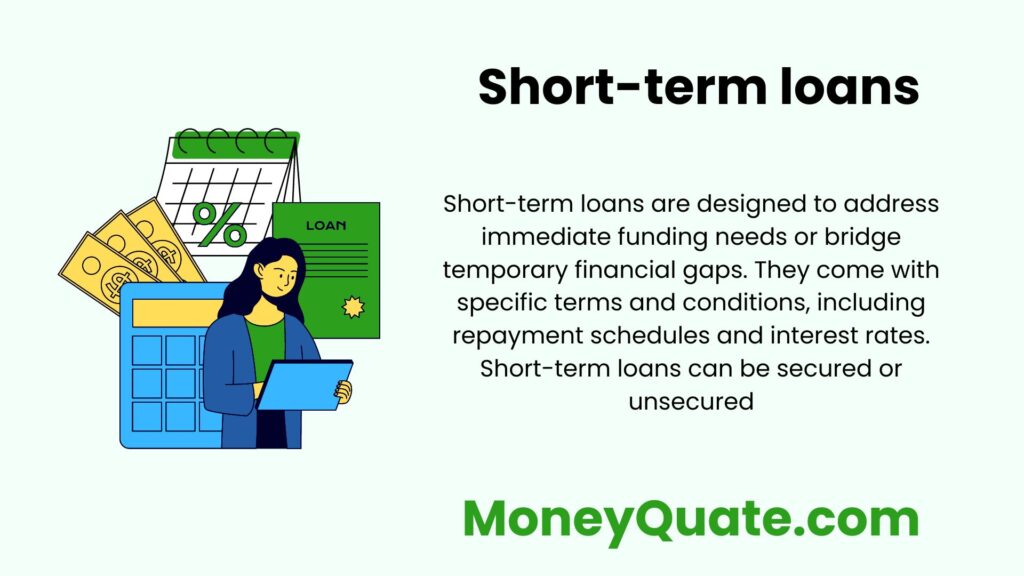Short-term loans are financial instruments with a relatively brief repayment period, typically ranging from a few weeks to a few years. These loans provide quick access to capital for businesses or individuals to address immediate financial needs. Here’s a detailed overview:

Contents
Key Features of Short-Term Loans
Duration:
Short-term loans have a brief repayment period, often less than one year.
Example: A business secures a short-term loan to cover seasonal fluctuations in working capital.
Purpose:
These loans are commonly used for immediate financial needs, such as covering operating expenses, managing cash flow gaps, or seizing short-term business opportunities.
Example: A small business takes a short-term loan to purchase inventory for a busy holiday season.
Interest Rates:
Interest rates for short-term loans can vary, but are generally higher than long-term loans due to the perceived higher risk and the quick turnaround.
Example: A business may pay a higher interest rate on a short-term loan compared to a traditional long-term loan.
Collateral:
Depending on the lender, short-term loans may be secured or unsecured. Secured loans require collateral, while unsecured loans do not.
Example: A business provides inventory as collateral for a short-term loan to reduce the risk for the lender.
Quick Approval Process:
Short-term loans often have a faster approval process compared to long-term loans, making them suitable for urgent financial needs.
Example: An entrepreneur secures a short-term loan to take advantage of a time-sensitive business opportunity.
Types of Short-Term Loans
Payday Loans:
Unsecured loans designed to cover expenses until the borrower’s next paycheck.
Example: An individual takes a payday loan to cover unexpected medical expenses.
Lines of Credit:
Flexibility to borrow up to a predetermined limit, with interest paid only on the amount borrowed.
Example: A business uses a line of credit to manage working capital fluctuations.
Merchant Cash Advances:
Advances based on future credit card sales, repaid through a percentage of daily credit card transactions.
Example: A restaurant owner uses a merchant cash advance to renovate the establishment during a slow season.
Invoice Financing:
Using unpaid invoices as collateral to secure a loan, providing immediate cash flow.
Example: A small business obtains financing by using outstanding customer invoices.
Online Loans:
Loans provided by online lenders, often with a straightforward application process.
Example: An e-commerce business secures an online loan to invest in marketing during a sales promotion.
Considerations and Risks
Higher Costs:
Short-term loans may have higher interest rates and fees compared to long-term financing options.
Example: A borrower pays a higher annual percentage rate (APR) on a short-term loan due to its quick repayment period.
Quick Repayment:
Borrowers need to repay short-term loans quickly, which can impact cash flow.
Example: A business owner allocates a portion of daily sales to repay a short-term loan.
Risk Management:
Lenders may assess the risk of the borrower’s ability to repay within the short term.
Example: A lender evaluates a borrower’s financial stability before approving a short-term loan.
Summary
Short-term loans offer flexibility and quick access to funds but require careful consideration of costs, repayment terms, and the specific needs of the borrower. Whether for business or personal use, understanding the features and types of short-term loans is essential for making informed financial decisions.